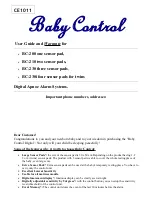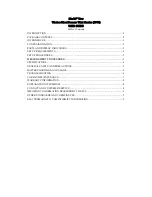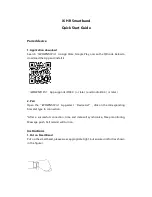
5017T Flat Panel Industrial Touch Monitor Chapter 2 – Installation
10
Noise commonly enters through input, output, and power supply lines and may also
be coupled through the capacitance between these lines and the noise signal carrier
lines. This usually results from the presence of high voltage or long, close-spaced
conductors. When control lines are closely spaced with lines carrying large currents,
the coupling of magnetic fields can also occur. Use shielded cables to help minimize
noise. Potential noise generators include switching components, relays, solenoids,
motors, and motor starters.
Refer to the relevant Federal, State/Provincial, and local electric codes, which
provide data such as the size and types of conductors, color codes and connections
necessary for safe grounding of electrical components. It is recommended that high-
and low-voltage cabling be separated and dressed apart. In particular, AC cables and
switch wiring should not be in the same conduit with all communication cables.
Line Voltage Variation
The power supply section of the unit is built to sustain the specified line fluctuations
and still allow the system to function in its operating margin. As long as the incoming
voltage is adequate, the power supply provides all the logic voltages necessary to
support the monitor unit.
Unusual AC line variations may cause undesirable system shutdowns. As a first step
to reduce line variations, correct any possible feed problems in the distribution
system. If this correction does not solve the problem, use a constant voltage
transformer. The constant voltage transformer stabilizes the input voltage to the
systems by compensating for voltage changes at the primary in order to maintain a
steady voltage at the secondary. When using a constant voltage transformer, check
that the power rating is sufficient to supply the unit.
Hazardous Locations Installations
Xycom Automation designed the systems with the intention of meeting the
requirements of Class I, Division 2 Hazardous Locations applications. Division 2
locations are those locations that are normally non-hazardous, but potentially
hazardous should an accident expose the area to flammable vapors, gases or
combustible dusts.
These systems are non-incendiary devices. They are not intrinsically safe and should
never be operated within a Division 1 (normally hazardous) location when installed as
described here. Nor should any peripheral interface device attached to these systems be
located within Division 1 locations unless approved and/or certified diode barriers are
placed in series with each individual signal and DC power line. Any such installations
are beyond the bounds of Xycom Automation design intent. Xycom Automation
accepts no responsibility for installations of this equipment or any devices attached to
this equipment in Division 1 locations.
It is the responsibility of the customer to ensure that the product is properly rated for
the location. If the intended location does not presently have a Class, Division, and














































